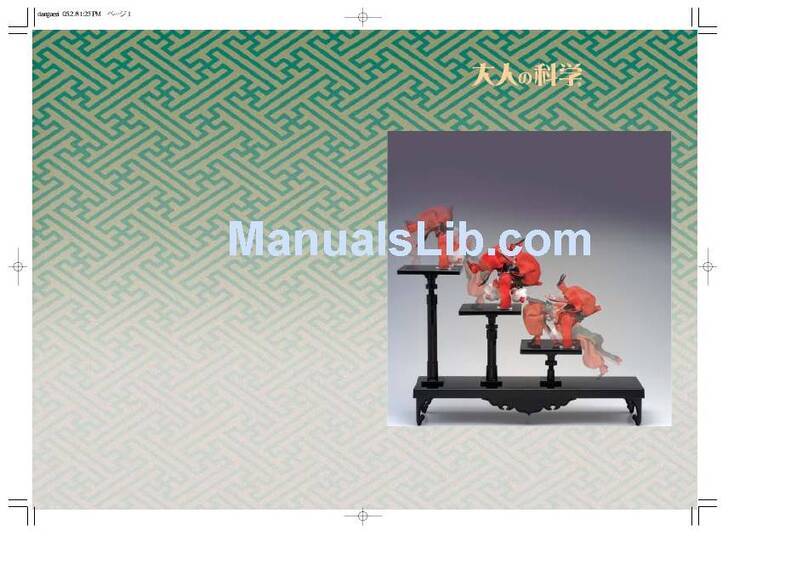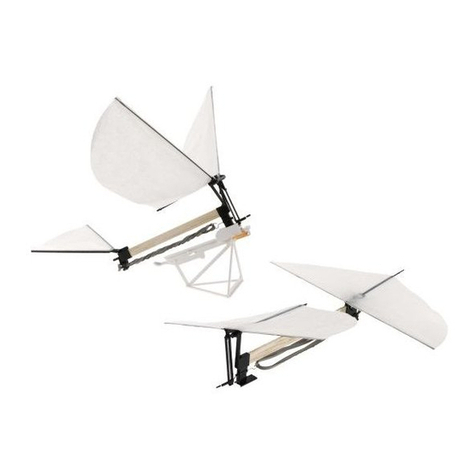Things you will need
Scissors, utility knife, etc.
Parts in the Kit
●Materials used in this kit
Crankshafts, frames, lower triangles, and wind turbine base (beige): ABS
Connecting rods, single-action rods, upper triangles, cogwheels, cogwheel shaft,
stoppers, and flange (beige): POM
Shafts: Iron Rubber feet, tubes: Silicon Blades: PET
How to Assemble and Use the Mini Strandbeest
Assembly time: Approximately 1.5 hours
CAUTION
Please be sure to read the following instructions
before assembling this kit.
●Take necessary caution when handling parts with pointed edges. There
is a risk of injury.
●Be careful when using the smaller parts so that you do not put them in
your mouth and accidentally swallow them. There is a risk of
suffocation.
●Keep this kit out of the reach of small children when not in use.
* Please read the instructions and cautions thoroughly before use.
* For your safety, be sure to follow the instructions in this manual. In
addition, do not use any parts that have become damaged or deformed
during use.
(A)Lower triangles (12) (B)Upper triangles (12)
(G)Frames (8)
Rubber feet (12) Stoppers (6)
Cogwheel (small)
Cogwheel (large)
Cogwheel shaft Flange
Shaft (short)
Shafts (long, 2) Wind turbine base
Rotating shaft
Rubber band
Double-sided tape
Tube (small)
Tube (large)
Blade
(C)Connecting rods (large, 12)
Crankshafts (2)
(D)Connecting rods (small, 12)
(E)Single-action rods (small,
12)
(F)Single-action rods
(large, 12)
Assembling the Body
[1] Assembling the legs of the Mini Strandbeest
1.Attach the rubber feet to the ends of the lower triangles
(A).
2.Attach a connecting rod (large) (C) to an upper triangle
(B).
3. Attach a connecting rod (small) (D) to an upper triangle
(B).
4. Attach a lower triangle (A) to two connecting rods.
5. Complete all twelve legs.
Complete Steps 2 to 4 a total of twelve times to assemble the twelve sets of
legs.
Make a total of
twelve sets like
this.
(A)
(A)
(B)
(B)
(C)
(C)
(D)
(B)
(C)
(D)
Rubber foot
After inserting a rubber foot
partway, push it all the way in
using the shaft (short).
Notches
Protrusions
Notches
Protrusions
(On the back)
Notch
Protrusion
[2] Attaching the crank to the legs
1. Attach the crankshaft to the frame (G).
Crankshaft
Protrusion
on joint
Protrusion on
joint
Protrusion
Line a rubber foot up with the slit on the
end of one of the lower triangles (A), and
then use the shaft (short) to push the rubber
foot into the hole to attach it. Adjust the
position of the rubber foot so that it lines up
with the middle of the slit. Do the same for
all twelve lower triangles (A) to attach a
rubber foot to each.
Attach the larger joint
on (C) to the largest
joint on (B), and then
rotate (C) 90°
downward.
Line the notches on
(C) up with the
protrusions on (B) to
attach (C) to (B).
Arrange the joint on (D) and
the joint on (B) so that the
protrusions and notches
line up as shown in the
diagram to attach (D) to (B),
and then rotate (D) 90°
downward.
Insert the crankshaft into
the slot in the middle of
the frame. There are three
protrusions on the frame
and a protrusion on the
joints at each end of the
crankshaft. Make sure
that the protrusion on the
crankshaft is facing in the
same direction as those on
the frame. Make two sets
like this.
2. Connect the right leg and crank together with a single-
action rod (small) (E).
Crankshaft
Frame (E)
Crank
Snap!
The leg should
be attached to
the joint on the
right side of the
frame as seen
from the side
with the
crankshaft.
Upper joint
Right leg
First, attach the joint on (A) with
the protrusion to the joint on (D),
and then rotate (A) upward to
attach the other joint on (A) to
the joint on (C) with the
protrusion. This completes one
leg.
Attach the largest joint
on the leg to the joint
on the right side of the
frame so that the
rubber foot on the leg
is at the bottom. Attach
(E) to the upper joint
on the leg so that the
protrusion and notch
line up, and then push
the key part on (E)
down onto the crank as
shown by the arrow so
that it snaps into place.
Attach the largest joint on the
leg to the joint on the left side
of the frame so that it is
opposite from the right side,
and then attach (F) to the
lower joint on the leg and push
it down onto the crank that
was attached in Step 2 so that
it snaps into place. When
completing this step, make
sure to position the newly
attached rod so that it is in
front.
(F)
Lower joint
Snap!
Left
leg
Right
leg
Frame
3. Connect the left leg and crank together with a single-
action rod (large) (F).
4. Connect the right leg and crank together with a single-
action rod (large) (F).
(F)
Left leg
Right leg
Frame
5. Connect the left leg and crank together with a single-
action rod (small) (E).
Upper
joint (E)
Attach (F) to the lower
joint on the right leg, and
then push it onto the crank
that was attached in Steps
2 and 3 until it snaps into
place. Make sure to
position the newly attached
rod so that it is in front.
Attach (E) to the upper
joint on the left leg, and
then push it onto the
crank that was attached
in Steps 2, 3, and 4 until
it snaps into place. Make
sure to position the
newly attached rod so
that it is in front.
Left leg
Right leg
Frame
Separate the parts from the plastic trees that they come attached to and arrange them as shown in the
picture.Remove each of the rubber feet at the cut lines one at a time.
* A left over rubber
foot is a spare.
Snap!
Frame
This is the same set as
seen from the back.
(A)
(B)
(C) (D)
Once you have attached both legs, check to make sure that the rods
attached to the crank are in the order of upper left, lower right, lower left,
and upper right, as seen from the front. If the order is different, the legs
may not move smoothly.





















